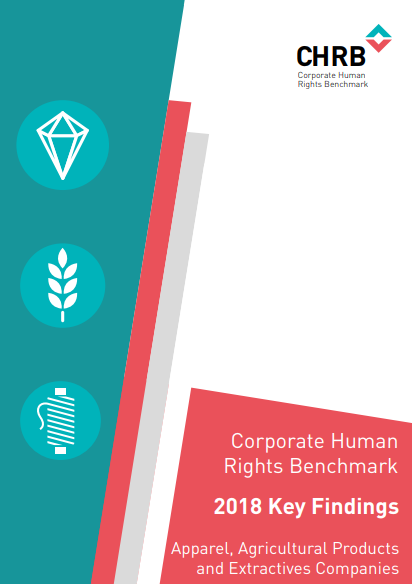Corporate Human Rights Benchmark: Pilot Methodology 2016
The CHRB pilot methodology assessed the top 100 companies across the agricultural products, apparel and extractives industries on their human rights policies, processes and performance.
The 2018 Corporate Human Rights Benchmark assesses 101 of the largest publicly traded companies in the world on a set of human rights indicators. The companies from 3 industries – Agricultural Products, Apparel, and Extractives – were chosen for the first Benchmark on the basis of their size (market capitalisation) and revenues and assessed across 6 Measurement Themes which have different weightings. Even though average scores are low across the board, overall companies tend to perform more strongly on policy commitments and management systems than on remedy or dealing with key risks in practice.

Average scores per region (source: CHRB 2018)
Some key takeaways from the results

The CHRB pilot methodology assessed the top 100 companies across the agricultural products, apparel and extractives industries on their human rights policies, processes and performance.
This Benchmark focuses on 98 companies of the three industries: Agricultural Products, Apparel, and Extractive. It is grounded in the UN Guiding Principles on Business and Human Rights, as well as additional standards and guidance focused on specific industries and...
The data in this report represents signals and cases from January 1, 2019 through December 31, 2019 and is accurate as of July 30, 2020. Cases of trafficking may be ongoing or new information may revealed to the National Hotline over time. Consequen...Read More
Research and analysis conducted by Katarina Schwarz (University of Nottingham) and Jean Allain (Monash University). To assess the extent to which slavery and related forms of human exploitation have been prohibited in domestic law, this project ...Read More
This study was conducted to identify the gaps in policies and practices of labour recruitment in Nepal and assess the outreach and engagement of major formal labour intermediaries, private recruitment agencies (PRAs) and pre-departure orientation tr...Read More
A new report from INTERPOL assesses the problem of trafficking in human beings for organ removal (THBOR), which is driven largely by the global shortage in organs for ethical transplant. While organ trafficking exists in all regions of the world, it...Read More